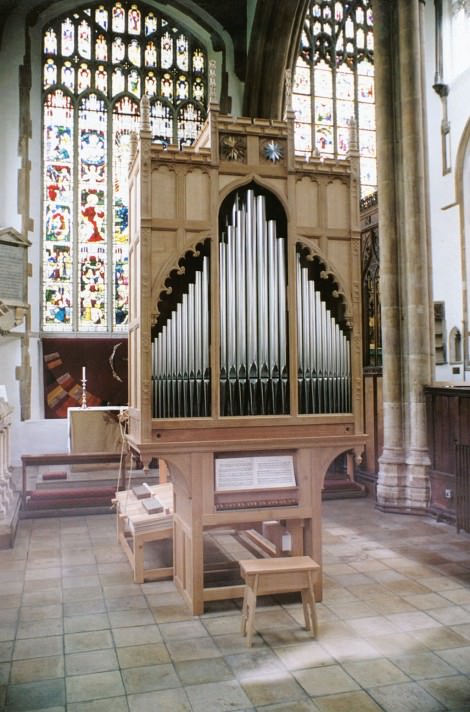
The new organ is based on the soundboard found in recent years at Wetheringsett in Suffolk (hence the name). It was discovered during alterations to a farmhouse, and may have been a dairy door. According to tree-ring dating the tree of which the original soundboard was made (from Baltic oak) cannot have been cut down before about 1525. The likeliest local church for this organ is at Debenham, a large church which bought an organ in 1525. It is likely that this organ stood on the floor, or against the wall in a gallery, and was probably the main organ of the church.
It is known that there were continental organbuilders being paid for new parish church organs in the first half of the 16th century in England, but the indigenous characteristics of this organ suggest that this organ was made by an English builder, probably fairly local, since there were some well-known East Anglian builders. These characteristics can be summarised as: long, fully chromatic key compass, choruses of wooden or metal pipes of the same scale and style, each with its own slider, and a voicing style familiar from 17th century English organs.
SPECIFICATION
Stoplist: The pitch and scaling of the stops are indicated by the spacing and the toehole sizes on the old soundboard. The order is that of the sliders and stop knobs, from the front.
| I. | short resonator reed | regal | 5ft | |
| II. | open metal | principal | 5ft | (C C# and D shared with other Principal) |
| III. | open metal | principal | 5ft | (27 pipes D# – f_ in the front) |
| IV. | open metal | octave | (C shared with other Octave) | |
| V. | open metal | octave | ||
| VI. | open metal | fifteenth | ||
| VII. | stopped wood | basses | 10ft | (C to f#º, 19 notes) |
Key compass: The key compass is C to a², 46 notes, which is the number of grooves in the Wetheringsett soundboard. This compass matches the ranges needed for the surviving repertory. The two C organs at All Hallows by the Tower in London (1519), and Holy Trinity Coventry (1526) would also have had an upper limit of a². This key compass allows for techniques of transposition by the player, which may have been quite subtle (by a fourth, a fifth or a tone).
Pitch: The nominal pitch is 5ft, i.e. a fourth above singing pitch. 5ft Principal ranks were the basis of the two organs mentioned above. For the actual pitch I have chosen the pitch of the earliest unaltered English pipes (the dummy pipes of the 1630 Dallam organ now at Stanford on Avon), which are about 1½ semitones above A440 at singing pitch. We have to assume that this pitch pre-dated use alongside choirs, but that it encouraged subtleties of technique in ‘accompanying’ which we have yet to learn.
Tuning: The tuning system is the tuning system recommended by Arnolt Schlick in his Spiegel der Orgelmacher published in Heidelberg in 1511, and intended as a guide for good practice throughout the Holy Roman Empire. He was the first writer to give a recipe which mentions every note of the scale. It is a modified form of mean tone tuning, with good (not pure) major thirds and the wolf spread to some extent over neighbouring fifths to allow some modulation (though ab for instance is still much closer to being a g#).
Dimensions
The outside dimensions of the organ are
| height total | 340cm (375cm with pinnacles) | 134ins (148ins) |
| height to impost | 122cm | 48ins |
| plan at pipe level | 170cm wide x 78.5cm deep | 67ins x 31ins |
| plan at ground level | 98cm wide x 78.5cm deep | 39ins x 31ins |
| ground plan of the wind system | 134 x 134 | 53ins x 53ins |
| staging (= total floor space required) | 300 x 150 | 120ins x 60ins |
The recording is available from www.oxrecs.com OXCD-101 Organs & Voices of Tudor England, Geoffrey Webber directs the Choir of Gonville & Caius College, Cambridge with organist Magnus Williamson, featuring the Wetheringsett and Wingfield organs, a 40-page booklet describes the history and use of these type of organs during the Reformation with both sacred and secular, choral and keyboard interpretations of music performed at the time;
The organ is also used on www.oxrecs.com OXCD-106 Tudor Church Music from Durham Cathedral with the Durham Cathedral Choir and the Durham Cathedral Consort of Singers directed by James Lancelot with Keith Wright on the organ, with the Wetheringsett and Wingfield organs; and www.atmaclassique.com ATMA classique ACD2 2349 Thomas Tallis Complete keyboard works: Rachelle Taylor plays the Wetheringsett and Wingfield organs, and Malcolm Rose’s reconstruction of the harpsichord from the 1579 Theewes claviorgan, and Darryl Martin’s reconstruction of the ca1570 “AH” virginals
